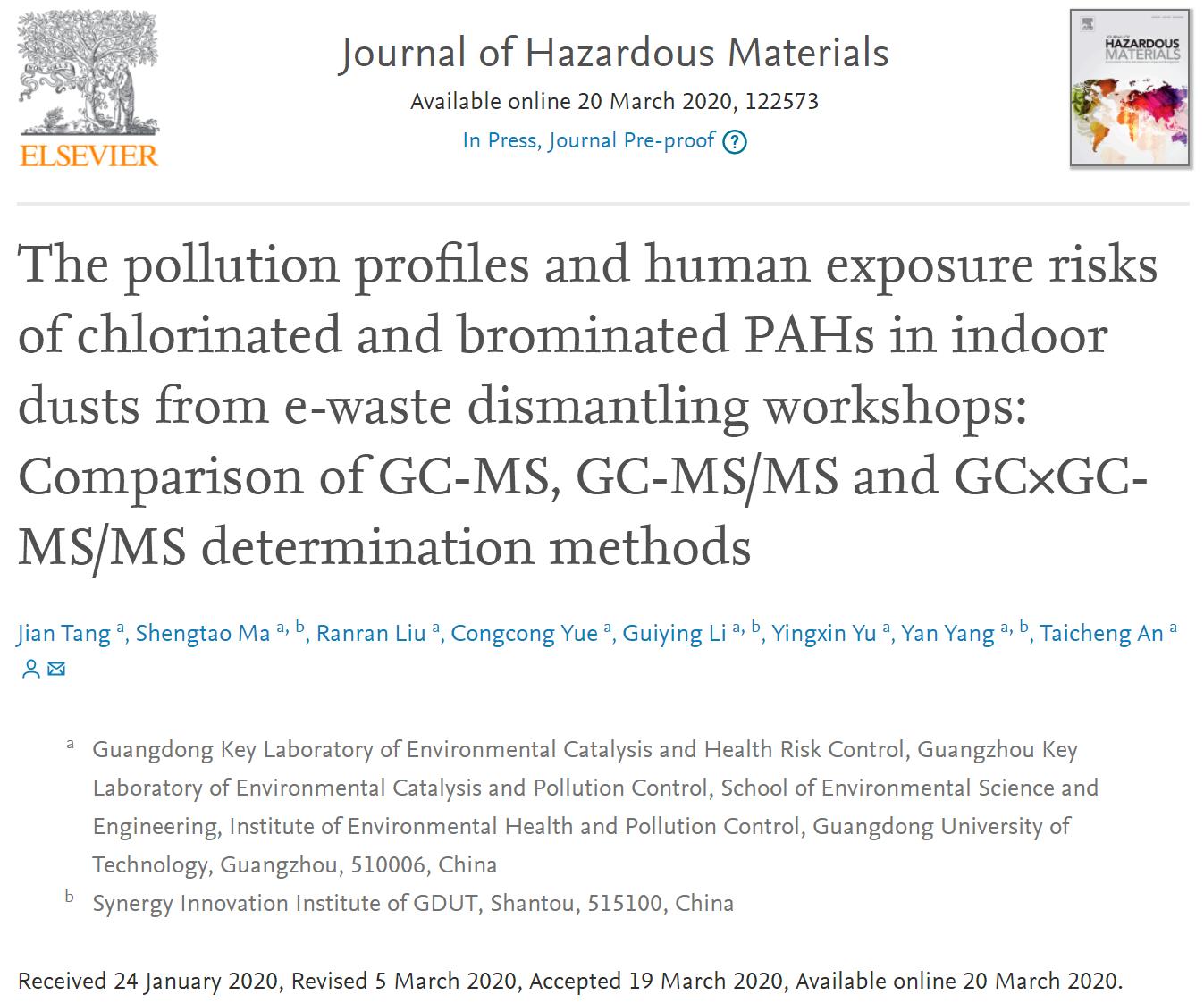近日,广东工业大学环境健康与污染控制研究院、环境科学与工程学院唐僭博士生等在电子垃圾拆解地区氯代和溴代多环芳烃的环境污染的方面取得最新研究进展,研究成果以《The pollution profiles and human exposure risks of chlorinated and brominated PAHs in indoor dusts from e-waste dismantling workshops: Comparison of GC-MS, GC-MS/MS and GC×GC-MS/MS determination methods, (2020): 122573》为题发表在Journal of Hazardous Materials杂志上。

该工作主要建立了有效分离和准确定量氯代和溴代多环芳烃的分析方法,并且采用三种不同的仪器方法GC-MS,GC-MS/MS和GC×GC-MS/MS测定氯代多环芳烃(Cl-PAHs)和溴代多环芳烃(Br-PAHs)并对方法进行比较,研究发现当使用GC-EI-MS/MS分析时,具有最佳选择性和灵敏度,其检测限可与GC-HRMS媲美。因此,成功应用于典型电子垃圾拆解地区不同车间的室内灰尘中氯代和溴代多环芳烃的分析,以及对该地区职业暴露人群进行健康风险评估。将GC-EI-MS/MS应用于电子垃圾拆解地区不同车间室内灰尘和标准灰尘(SRM 2585)中的Cl-PAHs和Br-PAHs定性和定量分析。结果发现:Σ18Br-PAHs的浓度高于Σ16Cl-PAHs的浓度,并且分别在电子垃圾拆解车间和电子垃圾原料破碎车间发现最高的Cl-PAHs和Br-PAHs毒性当量,本研究促进我们了解电子垃圾拆解地区不同车间工艺中氯代和溴代多环芳烃的形成机制,以及对职业暴露人群潜在的健康风险。本研究一方面揭示了Cl-PAHs和Br-PAHs在电子垃圾拆解地区沉降的粉尘中广泛存在,另一方面也揭示了基于灰尘摄入的Cl-PAHs和Br-PAHs对职业暴露人群造成潜在的健康风险。
论文网址:https://doi.org/10.1016/j.jhazmat.2020.122573.
论文英文摘要附如下:
ABSTRACT
The toxicities of some chlorinated and brominated polycyclic aromatic hydrocarbons (X-PAHs) are higher than their corresponding parent PAHs. However, the identification and quantitation of X-PAHs in environment are still changeable and limitedly reported. To develop a robust method for routine analysis of X-PAHs in environmental samples, the determination of 34 X-PAHs was performed and compared using different instruments, including gas chromatography-mass spectrometry (GC–MS), gas chromatography-tandem mass spectrometry (GC–MS/MS) in both electron ionization (EI) and negative chemical ionization (NCI) modes, and comprehensive two-dimensional gas chromatograph-tandem mass spectrometer (GC×GC–MS/MS). GC-EI-MS/MS possessed the highest sensitivity with method detection limits of 2.00–40.0 and 2.00–20.0 pg/g dry weight (dw) for Cl-PAHs and Br-PAHs, respectively. This validated method was then applied to analyze X-PAHs in indoor dusts from a typical e-waste dismantling workshop, and the concentrations of Σ18Br-PAHs (8.80–399 ng/g dw) were higher than Σ16Cl-PAHs (7.91–137 ng/g dw). The toxicity equivalency quantities (TEQs) of Cl-PAHs at e-waste dismantling workshop and Br-PAHs at raw materials crushing workshop showed the highest values of 176 and 453 pg·TEQ/g, respectively. Cl-PAHs and Br-PAHs posed a potential health risk to workers through dust ingestion in workshops. Further attention should be payed to the formation mechanism of X-PAHs and the health risk.